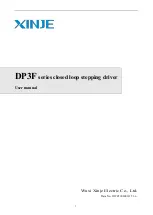
Goodrive350-19 series VFD for crane
Quick startup
-6-
Whether the actual environment humidity exceeds 90% or condensation occurs. If yes, take
additional protective measures.
Whether there is direct sunlight or biological invasion in the environment where the VFD is to
be used. If yes, take additional protective measures.
Whether there is dust or inflammable and explosive gas in the environment where the VFD is
to be used. If yes, take additional protective measures.
2.5 Checking after installation
Check the following after the VFD installation is complete.
Whether the input power cables and motor cables meet the current-carrying capacity
requirements of the actual load.
Whether correct accessories are selected for the VFD, the accessories are correctly and
properly installed, and the installation cables meet the capacity carrying requirements of all
components (including the reactor, input filter, output reactor, output filter, DC reactor, braking
unit and braking resistor).
Whether the VFD is installed on non-flammable materials and the heat-radiating accessories
(such as the reactor and braking resistor) are away from flammable materials.
Whether all control cables and power cables are run separately and Whether the routing
complies with EMC requirement.
Whether all grounding systems are properly grounded according to the VFD requirements.
Whether all the installation clearances of the VFD meet the requirements in the manual.
Whether the installation mode conforms to the instructions in the operation manual. It is
recommended that the VFD be installed uprightly.
Whether the external connection terminals of the VFD are tightly fastened and the torque is
appropriate.
Whether there are screws, cables, or other conductive items left in the VFD. If yes, get them
out.
2.6 Basic commissioning
Complete the basic commissioning as follows before the actual use of the VFD:
According to the actual motor parameters, select the motor type, set motor parameters, and
select the VFD control mode.
Check whether autotuning is required. If possible, de-couple the VFD from the motor load to
start dynamic parameter autotuning. If the VFD cannot be de-coupled from the load, perform
static autotuning.
Adjust the ACC/DEC time according to the actual work condition of the load.
Perform commissioning by means of jogging and check whether the motor rotational direction
is correct. If not, change the rotation direction by swapping any two motor phase wires.
Set all control parameters and then perform actual run.
















































